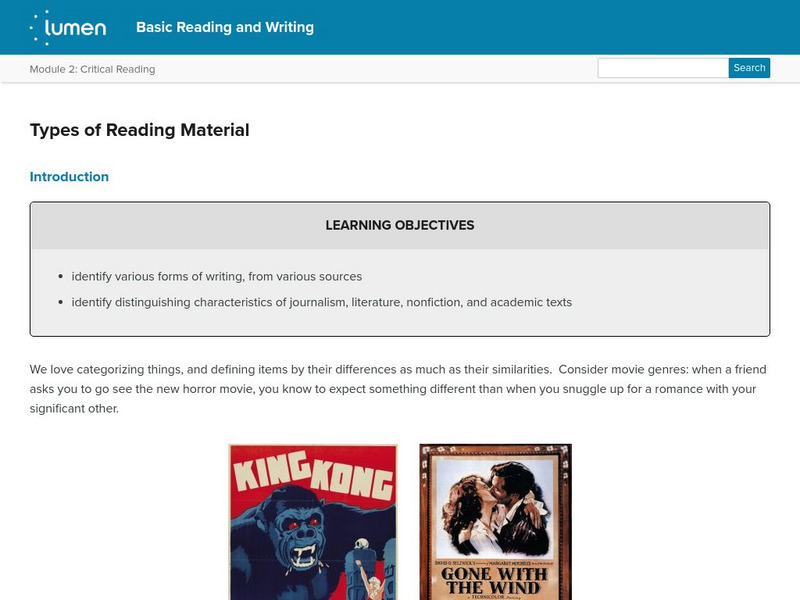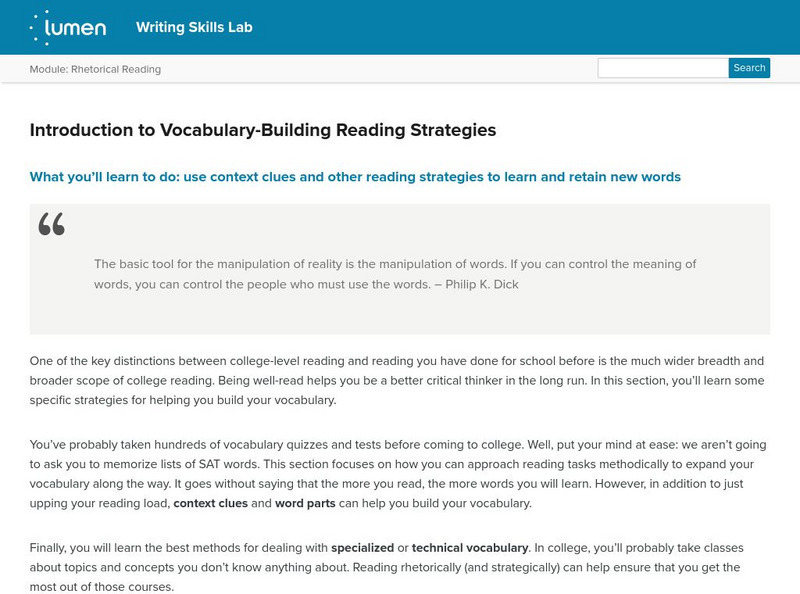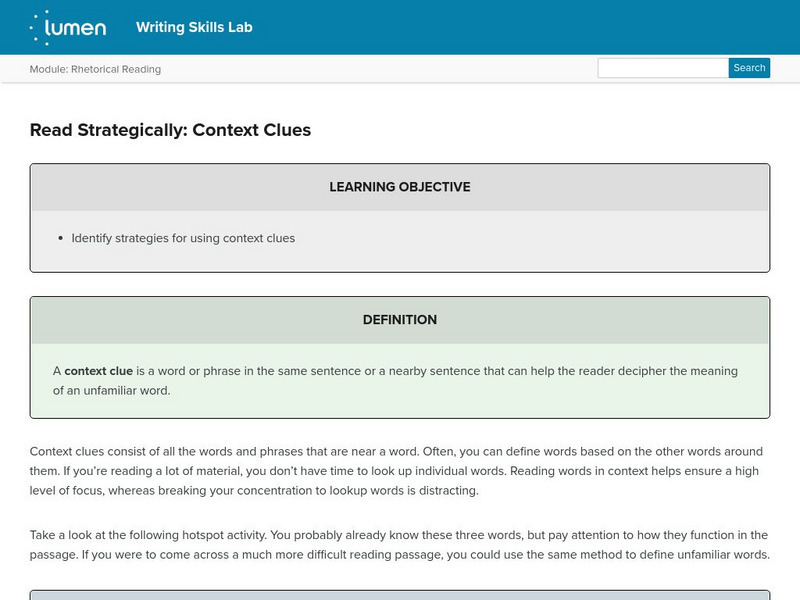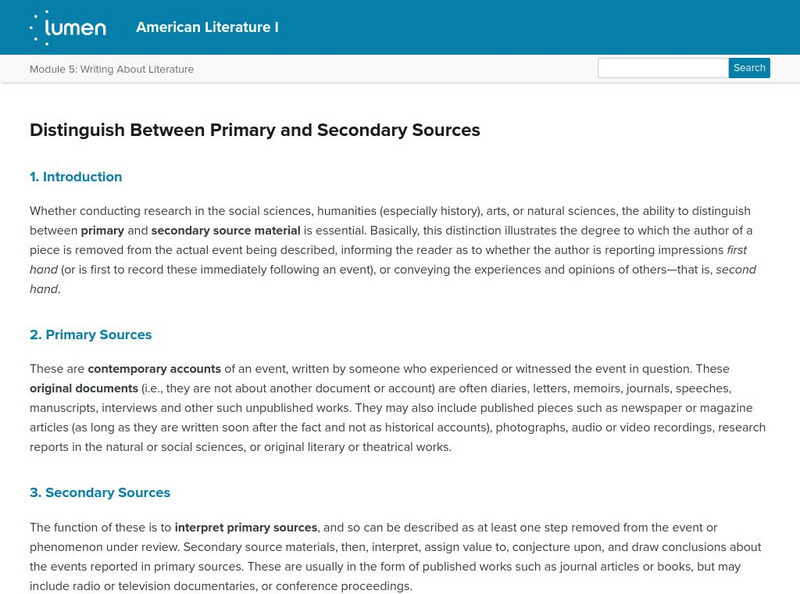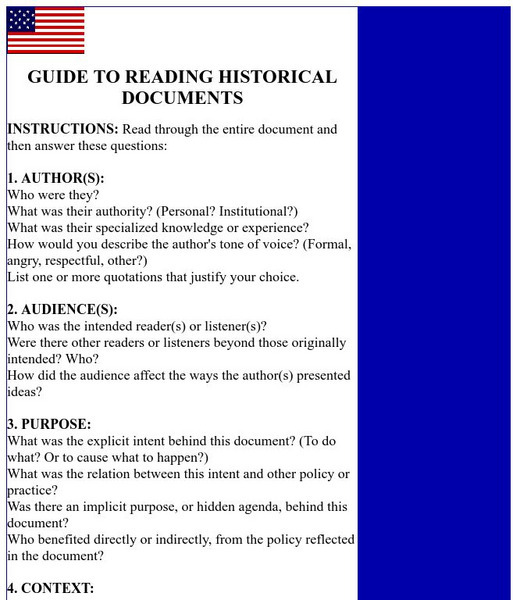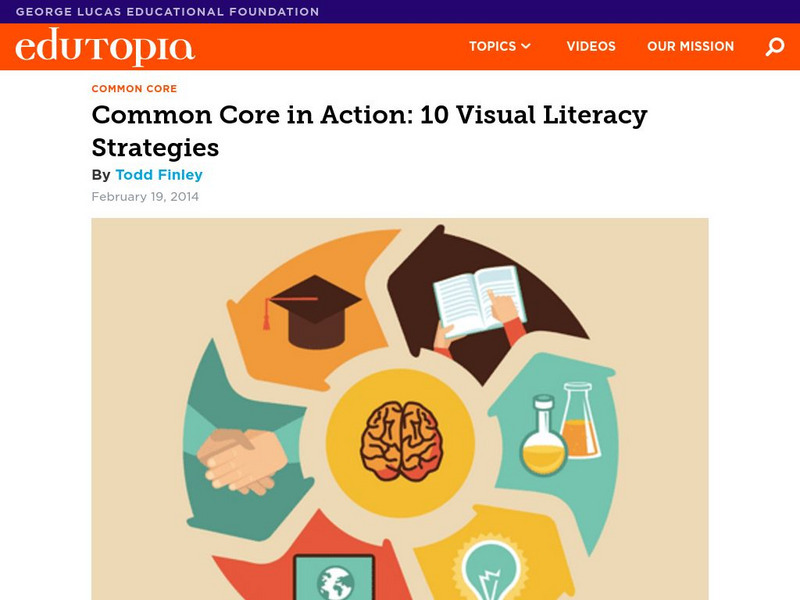University of California
History Project: Process of Historical Investigation [Pdf]
Outlines the process of historical investigation for students by teaching them the steps of research, analyzing evidence, and making interpretations.
Other
Fair: Retractions of Reporting Are Quite Selective
Interesting essay on the use of unnamed or anonymous sources, accuracy of reports, and retractions of innaccurate reports by major news outlets. Eye opener.
Lumen Learning
Lumen: Critical Reading: Types of Reading Material
This lesson focuses on the types of reading material and their distinguishing features. It also included two videos including the key features from a newspaper story video and a video that defines scholarly articles.
Lumen Learning
Lumen: Rhetorical Reading: Strategies for Active Reading
This instructional activity focuses on strategies for active reading such as annotating your texts, reading multiple times, and using your prior knowledge.
Lumen Learning
Lumen: Rhetorical Reading: Intro to Vocabulary Building Reading Strategies
This article explains in general how to build vocabulary using reading strategies such as context clues.
Lumen Learning
Lumen: Rhetorical Reading: Read Strategically: Context Clues
This lesson focuses on using context clues to determine word meanings while reading including synonym, definition, example, contrast, experience, or adjacent clues. L.11-12.4d Verify meaning
Lumen Learning
Lumen: Distinguish Between Primary and Secondary Sources
This lesson focuses on distinguishing between primary and secondary sources and evaluating them. It includes a list of questions to ask to determine the value of the sources under consideration.
Lumen Learning
Lumen: Writing About Literature: Finding Literary Criticism
This article focuses on how to find literary criticism including scholarly journals, citations from other works, a list of useful links to find sources, and TAMU libraries' website.
University of Victoria (Canada)
Uvcs: Critical Reading Exercise
Students read quotations from different "interest groups" or "lobbies" in this exercise and then perform a multiple-choice test to evaluate the credibility of each lobby group.
Huntington Library
Huntington Library: Using Primary Sources in the Classroom [Pdf]
This instructional activity provides guidelines for teaching students how to use primary sources such as images, text, or statistics (e.g., maps, census). Includes a document analysis worksheet.
Other
Library of Congress: Teaching With Primary Sources
This website is an excellent resource for teaching with primary sources. This resource features Holocaust lessons, lesson plan strategies, and podcasts.
US National Archives
Nara: Teaching With Documents: Teaching With Documents
Site from National Archives provides copies of primary documents that can be used while presenting various topics in U.S. history.
Roy Rosenzweig Center for History and New Media
Teaching History: Interactive Historical Thinking Poster (Secondary)
This is an interactive historical thinking poster. History is an argument about the past. Constructing a narrative about history involves several tasks: Analyzing Primary Sources, Examining Source Information,Using Evidence to Support...
Pennsylvania State University
Pennsylvania State University (Dr. Mc Clennen): How to Do a Close Reading
This guide is written for college students, but should be very useful for upper level high school students as well. The writer first describes fourteen steps to take in doing a close reading, then provides six pieces of advice on how to...
Other
Wisewire: Grades 9 10 Playlist: Analyze How an Author Unfolds an Argument
This is an example of how to analyze how an author unfolds an argument. It provides an example and links to use for practice. RI.9-10.3 author unfolds
CPALMS
Cpalms: Lafs.1112.rst.1.3: Follow Precisely a Complex Multistep Procedure
Find a collection of standards-aligned teacher and student resources where students follow procedural text.
National Endowment for the Humanities
Neh: Edsit Ement: I'm Gonna Sit Right Down and Write Someone a Letter
Through the vast online resources available from EDSITEment, students can read the correspondence of the famous, the infamous and the ordinary, some of whom lived through extraordinary times. Use these fascinating letters as a starting...
Schools of California Online Resources for Education
Score: Guide to Reading Historical Documents
Here are some questions that serve as a guide while you read and study historical documents. The information at this website was originally written by the National Council for the Social Studies. W.11-12.9b US Doc Analysis
CommonLit
Common Lit: Text Sets
This is a collection of 35 Grade-Leveled text sets (4-11). They are great for social studies teachers or for building background knowledge in reading class, CommonLit's text sets cover a range of historical, cultural, and political...
Other
National Council on Public History: Evidence of the Past
Understand how historians are like detectives- studying evidence from the past.
Alabama Learning Exchange
Alex: Interpreting Documents on the Ahsge
Learners will explore the documents that were used in shaping the United States, before, during, and after its creation. While studying these documents, students will use reading skills to interpret and analyze documents. By the end of...
Alabama Learning Exchange
Alex: Writing About Issues in the Media
In this instructional activity students analyze media coverage of current issues and present their findings in a formal research paper and class presentation.
Edutopia
Edutopia: Common Core in Action: 10 Visual Literacy Strategies
Explicitly teach a collection of competencies that will help students think through, think about, and think with pictures.
Khan Academy
Khan Academy: Approaches to Knowledge
An article addressing how knowledge is acquired from different media formats. The article also discusses how scholars from the past asked questions about knowledge and launched their own investigations.


![History Project: Process of Historical Investigation [Pdf] Handout History Project: Process of Historical Investigation [Pdf] Handout](https://d15y2dacu3jp90.cloudfront.net/images/attachment_defaults/resource/large/FPO-knovation.png)

